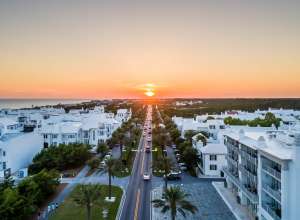History of SoWal and Walton County, Florida
Walton County was founded in 1824 and originally was comprised of more than 2,900 square miles including parts of Okaloosa, Washington, and Holmes counties. The first census in 1830 showed the county having a population of 1,207. Euchee and Creek Indians originally inhabited the area. In 1808, the first non-Native American settlers came to the area from Scotland. In 1890, the sawmill town of Point Washington was founded marking the first economic engine in the area - timber.
The same year, Grayton Beach was also platted, marking the next great economic engine that would eventually define the county - tourism. In the 1700's and 1800's the Muscogee / Creek / Euchee Indians lived in and around the DeFuniak Springs area. Lake DeFuniak area was known as Big Pond. Some of these Native American families are still in the area today. Members of the Muscogee Nation of Florida live in and around DeFuniak Springs. In the 1880's, a surveying party comprised of Colonel W.D. Chipley, Major W.J. VanKirk and W.T. Wright came to a tired halt near a round lake in the heart of a virgin forest.
They explored and rested at the site of what is now Lake DeFuniak. Colonel W.D. Chipley, so overwhelmed by the beauty set forth before him, exclaimed, "here a town shall be built!" This was when they first envisioned DeFuniak Springs known as Lake DeFuniak, in honor of Fred R. DeFuniak, who had held many high offices in the Louisville and Nashville Railroad, including that of General Manager. Later, the park around the lake was named Chipley Park, in honor of William Dudley Chipley.
Today, Lake DeFuniak is said to be one of two perfectly round lakes in the world. Under an order from Colonel W.D. Chipley, the area known as Lake DeFuniak was preserved and a station was built there. With the establishment of the station at Lake DeFuniak, people moved up from Euchee Anna and Alaqua and built homes near the lake.
At the same time that the Chautauqua organization received its charter in 1855, the Legislature created the Lake DeFuniak Land Company with Chipley in charge and the real estate boom was on. Today a permanent carousel of homes can be found around the lake which would envision a walk into Victorian times when labor and materials were plentiful and elaborate architectural details were incorporated. De Funiak Springs Library The Walton-DeFuniak Library was established in 1886.
It is the second oldest in Florida, with only the library in St. Augustine considered as being older. However, some facts have come to light recently which prove that our library is the oldest in the state that was built as a library and still continues to be used as such. On March 4, 1881, the Pensacola and Atlantic Railroad was incorporated by an act of the Florida Legislature.
The purpose of the act was to construct a 70-mile road from the northwest corner of Florida, near Flomaton, Alabama, where it would join the trackage of what started as the Pensacola and Selma Railroad. This was later in the control and ownership of the Louisville & Nashville, to a connection with the existing Seaboard. Colonel Chipley, in an address delivered in 1896, noted that he had been a member of the 1881 surveying party and that they had camped on the shore of a large pond in Walton County. Being enamored of the spot, Chipley ordered that the area be preserved and that a station be built there.
Chautaqua Building The City of DeFuniak Springs is the current owner of The Depot Station located on 1140 Circle Drive. The Walton County Heritage Association has transformed it into a Museum with Historical items from Walton County to include DeFuniak Springs. Also The Walton County Heritage Association handles the Caboose and Information Center on Circle Drive. For their hours of operation or other information please contact them at 850-951-2127.
The Historic Chautauqua Building is also owned by the City of DeFuniak Springs and is located at 96 Circle Drive. The Chautauqua Building (A.K.A. Hall of Brotherhood) was established in 1909 and served as an enclosed amphitheater. The building was fully equipped with foot lights and dissolving color effects for the presentation of many plays and grand concerts. This large portion of the auditorium was severely damaged during a hurricane in 1975 and was subsequently removed. Remaining portions of the building have been restored and continue to serve as a focal point of the community, being used for a wide variety of activities.













